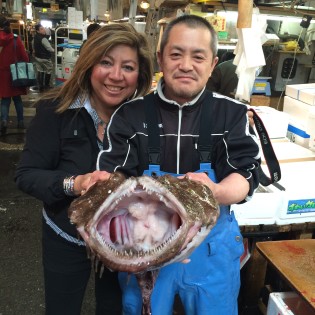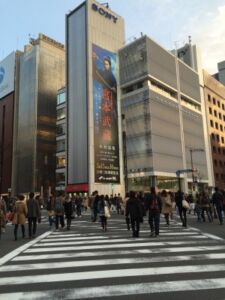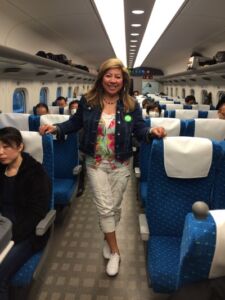
 I anticipated my adventure in Japan so much because I am fond of many things Japanese, the food, the people, the work ethic, electronics, Hello Kitty, and others. To boot, my Japanese friends in the Twin Cities awoke my curiosity even more about this amazing culture by sharing great information and tips prior to my trip.
I anticipated my adventure in Japan so much because I am fond of many things Japanese, the food, the people, the work ethic, electronics, Hello Kitty, and others. To boot, my Japanese friends in the Twin Cities awoke my curiosity even more about this amazing culture by sharing great information and tips prior to my trip.
I was all eyes, ears and nose as I usually am in other countries. Tokyo was awesome (downtown Tokyo picture on left). Sushi was plentiful in just about every corner and surprisingly inexpensive. People stood at fast food noodle houses (where you order via vending machines) and sushi restaurants to eat on the fly, or sat down at tiny restaurants with sushi boats floating around the sushi bar. Here you could make your own green tea at your station. There were hot water taps attached to the bar, small cups, and green tea powder. Some sushi looked just like what we find in the US and other totally unfamiliar and intriguing. I tried it all!
My family and I were so fortunate to have friends in Tokyo to show us and take us around the traditional, trendy, and cool places. On the picture to the left is my chef friend Masahiro Ono, who owns a high-end Kyoto-style restaurant in the business district nearby the railroad station. During our visit, I toured his tiny kitchen and he proudly showed me his set of super sharp stainless steel knives worth a fortune. Later we ate at his restaurant. His food and presentation to say the least were outstanding.
 The Tsukiji Fish Market was incredible. If you visit at 5 a.m. when all the boats have delivered the freshest catch, you will see fish brokers and restaurateurs compete for the best seafood available. It is a bustling place! While walking through the narrow aisles in between the countless stalls, we had to avoid getting hit by the motorized carts that circulate within the market nonstop. The picture at the top left shows a fish monger with a very large and scary looking flat fish which was alive at the time of the picture. Soon after he stuck a knife through his head to kill it quickly and proceeded to cut it up with such ease for sale. Not a pretty sight for the faint of heart.
The Tsukiji Fish Market was incredible. If you visit at 5 a.m. when all the boats have delivered the freshest catch, you will see fish brokers and restaurateurs compete for the best seafood available. It is a bustling place! While walking through the narrow aisles in between the countless stalls, we had to avoid getting hit by the motorized carts that circulate within the market nonstop. The picture at the top left shows a fish monger with a very large and scary looking flat fish which was alive at the time of the picture. Soon after he stuck a knife through his head to kill it quickly and proceeded to cut it up with such ease for sale. Not a pretty sight for the faint of heart.
Another highlight was riding on the famous bullet train to Kyoto (see picture below). The remaining cities we visited, namely the Alps of Takayama (Shogun country), Kanazawa (famous for its thatched- roof farmhouses), were all equally charming. As we progressed from place to place, not only the sights and weather changed dramatically (heavy snow in the mountains), but also the cultures. Having just left Minnesota winter behind a few weeks prior, I came to find it all over again in Takayama!
roof farmhouses), were all equally charming. As we progressed from place to place, not only the sights and weather changed dramatically (heavy snow in the mountains), but also the cultures. Having just left Minnesota winter behind a few weeks prior, I came to find it all over again in Takayama!
The most revealing things that I discovered were totally unexpected. They drive on the left side of the road. This is a homogeneous society who does not assimilate other cultures (even the ones living in it) and speak virtually no English. We became very creative trying to communicate. This is a cash society. Outside of Tokyo (and even inside) it is challenging using a credit card. Their transportation system is efficient, safe, and clean. Trains function like clockwork. It is the easiest and stress-less way to move from place to place.
My admiration for the Japanese culture grew as I became more informed about their history. Among all  the ancient dynasties, the Meiji is the one that really made significant contributions to the country and opened it to the western world. Prior to this, Japan had been a self-sufficient, landlocked country with no access to the outside world. The ruling emperor during the Meiji Restoration period also imported western ways bringing talented labor from Europe to reconstruct and build the infrastructure. Then I understood why they drive on the left. Along with English engineers came the cars.
the ancient dynasties, the Meiji is the one that really made significant contributions to the country and opened it to the western world. Prior to this, Japan had been a self-sufficient, landlocked country with no access to the outside world. The ruling emperor during the Meiji Restoration period also imported western ways bringing talented labor from Europe to reconstruct and build the infrastructure. Then I understood why they drive on the left. Along with English engineers came the cars.
One isolated episode that I will remember forever is that the Japanese are very honest. I thought I had lost a pair of diamond studs in a tiny mesh bag that I inadvertently left behind at the breakfast table. I didn’t realize this until I was on the bullet train en route to Kyoto. In Kyoto our hotel concierge contacted the hotel we just left behind. To our amazement, they not only said they had the earrings, but that they would send them to us by overnight courier!
Like the US, Japan is an aging country with the largest amount of centenarians (the majority being women) in the world. The longevity is attributed to lifestyle and a simply healthy diet. Although very high quality beef is eaten occasionally as sashimi, many of their dishes revolve around the same wholesome ingredients prepared in creative and delicious ways. Southeast Asia consumes nearly 70% of the world’s fish and seafood. Soy is present in many different styles of foods from fresh beans (edamame), soups and tofu, to drinks and sauce, and many more. Green tea (high in antioxidants) is the drink of choice. Fresh bean sprouts, fermented red beans and other foods (pictured on right) contribute beneficial probiotics, digestive enzymes, and health-boosting benefits.
same wholesome ingredients prepared in creative and delicious ways. Southeast Asia consumes nearly 70% of the world’s fish and seafood. Soy is present in many different styles of foods from fresh beans (edamame), soups and tofu, to drinks and sauce, and many more. Green tea (high in antioxidants) is the drink of choice. Fresh bean sprouts, fermented red beans and other foods (pictured on right) contribute beneficial probiotics, digestive enzymes, and health-boosting benefits.
Buddhism and Shinto are the main religions, and despite their homogeneity, Koreans and Chinese live harmoniously (not together) within the culture. From tea ceremonies, to ancient pottery factories and beautiful silk fabrics, the Japanese thrive in one of the smallest, ancient, and well developed countries on earth.
I can’t wait to visit again and see the rest of the country!

